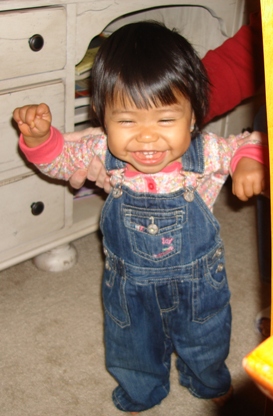October27
Most of us obsess over attachment. We watch for signs. We read books. We piss off extended family by asking them not to hold the baby the first few weeks. We keep a watchful eye for signs of healthy attachment and bonding and celebrate every shred of proof that it is happening. We try to explain our joy over little Johnny gazing into our eyes while we feed him a bottle.
We have been lucky in so many ways with Sabrina. She seems to have attached and bonded with us relatively easily. We struggled a bit the first few weeks in Guatemala but she is such an easy going child that our struggles didn’t compare to those of many who I met. Even though I am confident in where we are now, I still like to keep an eye on things. Attachment isn’t just done in 6 weeks or 6 months. It is an on going issue that we need to be aware of as adoptive parents.
Find the original list of signs of healthy attachment here. I left off the last couple simply because they aren’t age appropriate for Sabrina yet. I find that just taking a quick inventory like this every couple of months reassures me that all is well.
# Joyful the majority of the time. Check. Sabrina is a definitely joyful.
# Seeks out primary caregiver for comfort and to meet needs. Check.
# Likes to be cradled and held facing primary caregiver. Check.
# Makes good eye contact with primary caregiver and initiates eye contact–both close & distant proximity. Check.
# When primary caregiver makes eye contact, the child smiles back, showing signs of being happy with the interaction. Check.
# Smiles and exhibits pleasure when seeing self in the mirror. Check.
# Frequently engages in playful interactions with primary caregiver (interactions initiated by both parent and child.) Check.
# Uses different cries to alert primary caregiver of needs and wants; easily consoled by primary caregiver. Usually. Check.
# Accepts limits placed by primary caregiver. Usually. Check.
# Willingly allows primary caregiver to hold bottle, hand feed, and nurture. Check.
# Melts into primary caregiver when held; lays head on shoulder; holds on when held; faces primary caregiver rather than away. She doesn’t hold on when I carry her. But the rest of this – check.
# Enjoys cuddling, hugs, and kisses given by primary caregiver and initiates cuddling, hugs, and kisses without wanting something in return. Check.
# Can co-sleep without major difficulty. I can’t co-sleep without major difficulty but she is usually fine with it once she gets over the excitement of sleeping with mommy. Check.
# Prefers primary caregiver to all others. This one I can only confidently answer yes in the past 6-8 weeks. Prior to that I swear she would have left the grocery store with anyone who said she was cute. Now she gets a little shy with anyone who approaches closely to talk to her. She curls into me and puts her head on my shoulder – makes me melt! Check.
# Imitates primary caregiver regularly (actions, language, etc.) She and Steve have this sighing game in the car – he sighs, she imitates then they both giggles – cracks me up! Check.
# Content to sit on primary caregiver’s lap or stay in primary caregiver’s arms for an age appropriate amount of time. Check.
# Settles quickly when held by primary caregiver. Check.
# Enjoys skin on skin contact. Check.
# Prefers close proximity to primary caregiver but not in an anxious, desperate way. Check.
# Consistently sleeps well and peacefully. Usually. Check.
# Wants to please primary caregiver because he knows it will make his parent happy. Check.
# Reacts appropriately to pain; wants primary caregiver to nurture him when in pain or sick; easily consoled. She is a tough little girl but I’ll give this one a check too.
# Uses food appropriately. Recognizes when hungry and full. She definitely recognizes when she is hungry. The full part we are still working on.
# Shows true personality to primary caregiver and family and friends (discovering a child’s innate personality takes time.) Check.
# Initiates “sweet nothing” talk with primary caregiver. Check.
# Shows appropriate stranger anxiety. Check.
# Displays age appropriate anxiety at brief separation from primary caregiver but is able to be reassured. Usually. Check.
# Reunites happily with primary caregiver with eye contact and physical contact. Nothing better than the big smile I get when I return or the smile Steve gets when he comes home from work. Check.
# Show signs of feeling safe in social situations; able to play and interact with others, but stays close and checks in with primary caregiver regularly but not in an anxious or desperate way. Check.
# Is gentle to self and others. Usually. Sometimes hits mommy.
# Gets along with other children & siblings most of the time. Check.
# Is okay with primary caregiver leaving the room for short periods of time. Conversely, cares that primary caregiver has left the room and shows happiness when that person returns. Took awhile to get there but can now say check.
# Speech/language skills are developing appropriately. Check.
# Angry outbursts/tantrums are infrequent, short in duration. Parent can soothe child. Usually. Check.

Joyful seems like a good word.